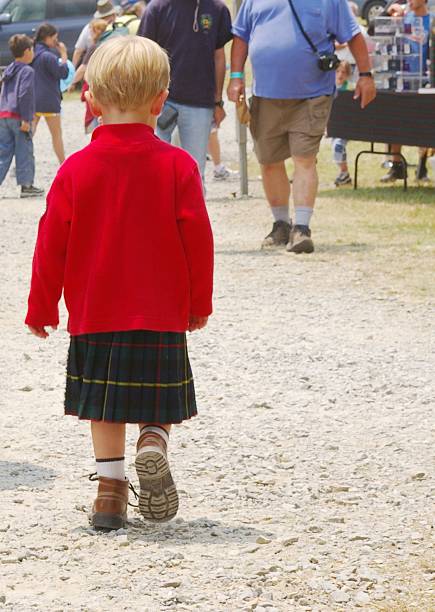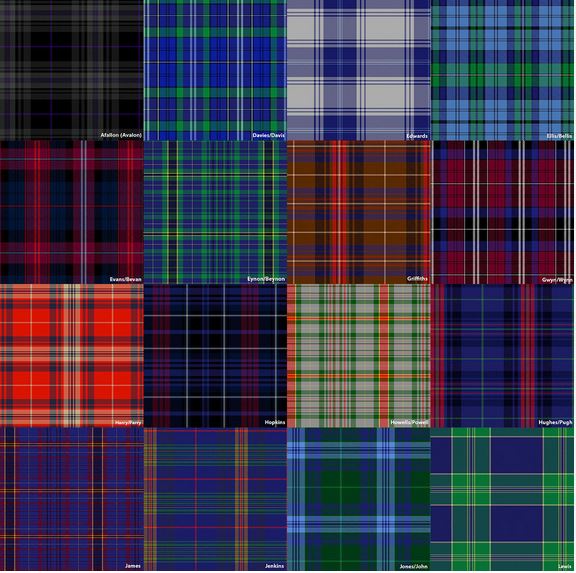Welcome to the captivating world of Clan Tartans, where tradition, history, and vibrant colors intertwine to create a tapestry of Scottish heritage. From kilts swaying in the Highland wind to family gatherings around crackling hearths, these tartans are more than just patterns – emblems connecting generations and telling tales of bravery, clan loyalty, and ancient lineage.
This article will delve into the fascinating realm of Clan Tartan Colors. Discover their significance, explore popular shades and meanings, learn how to find your tartan connection, unravel regional variations in colors across Scotland’s landscape, and uncover modern uses for these timeless symbols.
So buckle up (or should we say kilt up?) as we embark on a journey through centuries-old traditions steeped in color-rich stories!
The Significance of Colors in Clan Tartans
Colors play a significant role in clan tartans, as they add beauty to the fabric and hold deep symbolic meanings. Each color represents different aspects of Scottish heritage and history, reflecting the stories and values of the clans.
Red is one of the most common colors found in clan tartans. It symbolizes bravery, courage, and strength – highly valued qualities of Scottish warriors. Green represents Scotland’s lush landscapes and signifies fertility, growth, and hope for future generations.
Blue is often associated with loyalty and devotion to family or clan. It reflects the strong bonds between members of a particular lineage. Yellow or gold signifies wisdom, knowledge, and prosperity – traits held in high regard by Scottish clans.
Black can represent mourning for fallen ancestors or solemnity during important events like funerals. It can also signify resilience and determination in times of hardship. White or silver symbolizes purity, innocence, and peace. These colors are often used to highlight specific elements within a tartan design.
While these meanings may vary slightly from clan to clan, they collectively form an integral part of Scottish culture preserved through clan tartans.
Popular Tartan Colors and Their Meanings
Each clan tartan is uniquely designed, incorporating different colors with significant meanings. These colors not only represent the history and traditions of a specific Scottish clan but also reflect Scotland’s natural beauty and landscape.
One popular color found in many clan tartans is red. Red symbolizes strength, courage, and resilience. It is often associated with warriors and signifies the bloodshed during battles fought to protect one’s homeland.
Green is another commonly used color in clan tartans. Green represents the lush landscapes of Scotland – its rolling hills, forests, and fertile fields. It embodies growth, prosperity, and a deep connection to nature.
Blue can also be seen in various tartans – from light sky blue to dark navy blue. Blue represents loyalty, integrity, and determination. It reflects the vastness of the Scottish skies and seas surrounding this beautiful country.
Yellow or gold tones are often incorporated into tartan designs, too. Yellow symbolizes wisdom, wealth, and prestige. It represents sunlight shining on golden fields or ancient treasures hidden within castle walls.
Black holds its significance within clan tartans as well. Black represents power, sophistication, and elegance.
It adds depth and contrasts to other vibrant colors in the design. It also symbolizes the dark history of Scotland and the sacrifices made by the country’s ancestors. Tartan colors are more than just colors; they represent the heritage and values of each Scottish clan. Their meanings are subtle yet powerful. They reflect the strength, courage, and connection to such a beautiful land. Through the rich palette of tartan colors, the legacy of Scotland survives and influences generations after generations.
How to Find Your Clan Tartan
One of the most exciting aspects of being a part of a Scottish clan is finding your clan tartan. The tartan represents your family heritage and history with its distinct pattern and colors. But how do you go about finding the proper tartan for your clan?
It’s important to know which clan you belong to. Researching your family history or consulting genealogical records can help determine this. Once you’ve identified your clan, you can then search for the specific tartans associated with it.
There are various resources available to aid in this search. Websites dedicated to Scottish clans often provide detailed information on each clan’s tartans. Additionally, many companies specialize in producing and selling authentic clan tartans and can guide you in finding the one that corresponds to your lineage.
If you need clarification on which specific tartan belongs to your clan or if multiple options are available, consider contacting organizations such as The Scottish Register of Tartans or The Scottish Tartans Authority for further assistance.
It’s worth noting that while specific colors may be associated with different clans, variations within these colors exist due to regional influences and personal preferences over time. This means that even within a single clan, several versions of the same basic design may exist.
Finding your unique Clan Tartan is an exciting journey that connects you to generations past and allows you to celebrate your Scottish heritage in style! So embrace this opportunity to explore the rich tapestry of color and pattern that awaits – happy hunting!
Understanding Regional Variations in Tartan Colors
Clan tartans are a quintessential symbol of Scottish heritage and identity. These distinctive patterns, woven into the fabric, have deep historical roots that connect individuals to their ancestral clans. While the overall design of clan tartans remains consistent across regions, there can be variations in colors used.
The colors chosen for a specific clan’s tartan often reflect the natural landscape or local resources associated with that region. For example, clans from the Highlands may incorporate earthy tones like greens and browns to represent the lush forests and rugged terrain. In contrast, coastal clans might feature shades of blue to represent the nearby sea.
Regional climate and cultural influences can also impact color choices within a clan’s tartan. Clans from colder regions may include darker hues, such as deep reds or rich purples, to evoke warmth during harsh winters. On the other hand, clans from warmer areas might opt for lighter shades like yellows or oranges to capture a sense of sunshine and vitality.
It is important to remember that while there are general color associations with specific regions, these variations should not be seen as strict rules but as artistic expressions unique to each clan’s history and traditions.
By understanding these regional variations in tartan colors, one can gain a deeper appreciation for the diversity within Scottish culture. Whether exploring your clan’s history or simply admiring different designs from various regions, each variation offers its own story waiting to be discovered.
So next time you see a stunning tartan pattern adorned with vibrant colors, take a moment to appreciate how those hues reflect both nature and tradition – connecting present-day Scots with their rich ancestral pasts.
Modern Uses of Clan Tartans
In today’s modern world, clan tartans have gone beyond traditional kilts and become a famous symbol of Scottish heritage. People from all over the globe now proudly display their clan tartan in various ways, showcasing their connection to their ancestral roots.
One prominent modern use of clan tartans is in the fashion industry. Designers have incorporated these vibrant patterns into clothing and accessories, creating stylish garments that pay homage to Scottish culture. From dresses and skirts to scarves and ties, clan tartan has made its way onto runways and wardrobes worldwide.
Beyond fashion, clan tartans are also used for home decor. Whether it’s through curtains, upholstery, or blankets, incorporating these timeless designs adds a touch of authenticity to any living space. It allows individuals to create an atmosphere that reflects their heritage while adding warmth and character.
Additionally, many businesses embrace the symbolism behind clan tartans by using them as branding elements. Companies with Scottish origins often incorporate their respective tartan colors into logos or promotional materials. This connects them back to their roots and helps them stand out in a crowded market.
Furthermore, clan tartans hold significance during special occasions such as weddings or family gatherings. Couples may incorporate their respective clans’ colors into wedding attire or decorations as a tribute to both families’ histories coming together in union.
Moreover, social events like the Highland Games showcase the continued relevance of clan tartans in contemporary society. Participants proudly wear kilts adorned with specific clan colors while competing in traditional sports such as caber tossing or Highland dancing.
Conclusion :What Are The Clan Tartan Colors?
Clan tartans are not just beautiful patterns of fabric; they hold deep meaning and significance for those who proudly wear them. The colors used in clan tartans convey different messages and represent each clan’s heritage, history, and values.
Whether you are a member of a specific Scottish clan or appreciate the rich cultural traditions associated with tartan fabrics, understanding the meanings behind the various colors adds another layer of appreciation to these timeless designs.
Finding your clan tartan can be an exciting journey that connects you with your ancestral roots. You can discover which clan’s tartan is rightfully yours by exploring historical records or consulting with experts in Scottish genealogy and heraldry.
It is important to note that while certain colors may be associated with specific clans, there may also be regional variations within Scotland. These regional differences in color choices further demonstrate the complexity and diversity found within Scottish culture.
Today, clan tartans continue to play a role beyond traditional Highland dress. They have become famous symbols worn by individuals worldwide to honor their Scottish heritage or embrace the beauty of these iconic designs. From fashion runways to home decor items, modern uses for clan tartans abound.
So whether you don a kilt made from your family’s ancient tartan or incorporate some plaid into your everyday style, remember that every thread tells a story rooted in centuries-old tradition and cultural pride.









